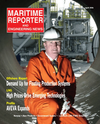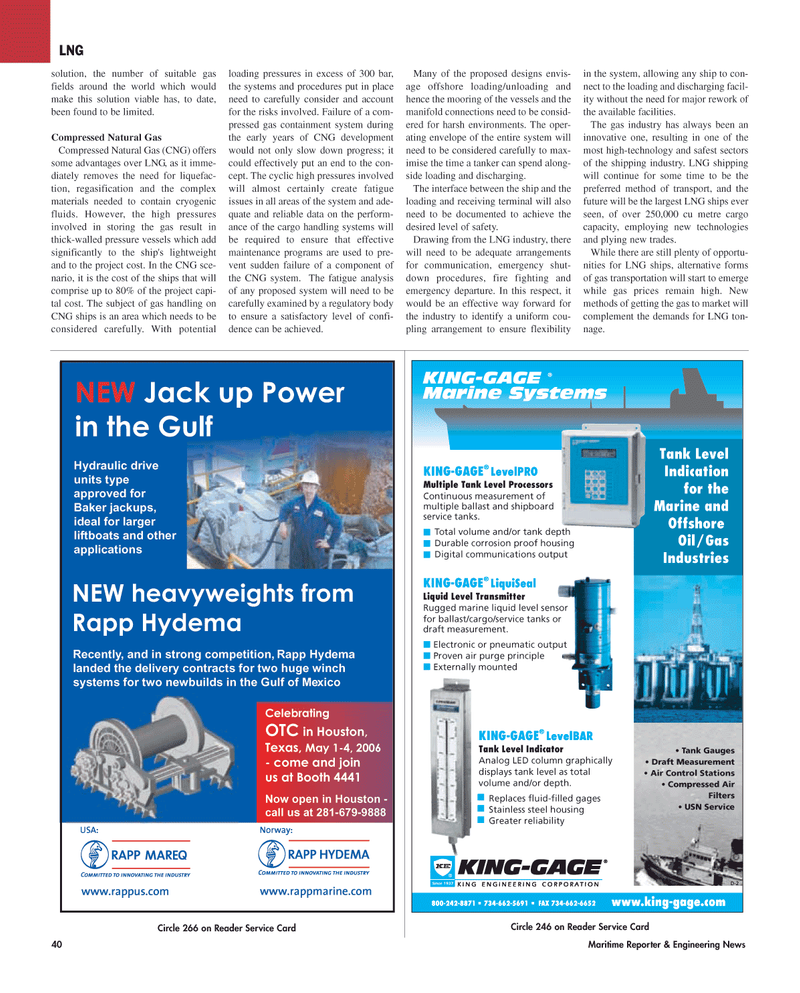
Page 40: of Maritime Reporter Magazine (April 2006)
The Offshore Industry Annual
Read this page in Pdf, Flash or Html5 edition of April 2006 Maritime Reporter Magazine
40 Maritime Reporter & Engineering News www.rappmarine.com Seattle: Norway:
Celebrating
OTC in Houston,
Texas, May 1-4, 2006 - come and join us at Booth 4441 USA: www.rappus.com
Hydraulic drive units type approved for
Baker jackups, ideal for larger liftboats and other applications
Recently, and in strong competition, Rapp Hydema landed the delivery contracts for two huge winch systems for two newbuilds in the Gulf of Mexico
NEW heavyweights from
Rapp Hydema Jack up Power in the Gulf
NEW
Now open in Houston - call us at 281-679-9888
Circle 266 on Reader Service Card
Circle 246 on Reader Service Card
KING-GAGE ®
LevelBAR
Tank Level Indicator
Analog LED column graphically displays tank level as total volume and/or depth. Replaces fluid-filled gages Stainless steel housing Greater reliability • Tank Gauges • Draft Measurement • Air Control Stations • Compressed Air
Filters • USN Service
KING-GAGE
Marine Systems ®
KING-GAGE ®
LevelPRO
Multiple Tank Level Processors
Continuous measurement of multiple ballast and shipboard service tanks. Total volume and/or tank depth Durable corrosion proof housing Digital communications output
KING-GAGE ®
LiquiSeal
Liquid Level Transmitter
Rugged marine liquid level sensor for ballast/cargo/service tanks or draft measurement. Electronic or pneumatic output Proven air purge principle Externally mounted Tank Level
Indication for the
Marine and
Offshore
Oil/Gas
Industries
D-2
LNG solution, the number of suitable gas fields around the world which would make this solution viable has, to date, been found to be limited.
Compressed Natural Gas
Compressed Natural Gas (CNG) offers some advantages over LNG, as it imme- diately removes the need for liquefac- tion, regasification and the complex materials needed to contain cryogenic fluids. However, the high pressures involved in storing the gas result in thick-walled pressure vessels which add significantly to the ship's lightweight and to the project cost. In the CNG sce- nario, it is the cost of the ships that will comprise up to 80% of the project capi- tal cost. The subject of gas handling on
CNG ships is an area which needs to be considered carefully. With potential loading pressures in excess of 300 bar, the systems and procedures put in place need to carefully consider and account for the risks involved. Failure of a com- pressed gas containment system during the early years of CNG development would not only slow down progress; it could effectively put an end to the con- cept. The cyclic high pressures involved will almost certainly create fatigue issues in all areas of the system and ade- quate and reliable data on the perform- ance of the cargo handling systems will be required to ensure that effective maintenance programs are used to pre- vent sudden failure of a component of the CNG system. The fatigue analysis of any proposed system will need to be carefully examined by a regulatory body to ensure a satisfactory level of confi- dence can be achieved.
Many of the proposed designs envis- age offshore loading/unloading and hence the mooring of the vessels and the manifold connections need to be consid- ered for harsh environments. The oper- ating envelope of the entire system will need to be considered carefully to max- imise the time a tanker can spend along- side loading and discharging.
The interface between the ship and the loading and receiving terminal will also need to be documented to achieve the desired level of safety.
Drawing from the LNG industry, there will need to be adequate arrangements for communication, emergency shut- down procedures, fire fighting and emergency departure. In this respect, it would be an effective way forward for the industry to identify a uniform cou- pling arrangement to ensure flexibility in the system, allowing any ship to con- nect to the loading and discharging facil- ity without the need for major rework of the available facilities.
The gas industry has always been an innovative one, resulting in one of the most high-technology and safest sectors of the shipping industry. LNG shipping will continue for some time to be the preferred method of transport, and the future will be the largest LNG ships ever seen, of over 250,000 cu metre cargo capacity, employing new technologies and plying new trades.
While there are still plenty of opportu- nities for LNG ships, alternative forms of gas transportation will start to emerge while gas prices remain high. New methods of getting the gas to market will complement the demands for LNG ton- nage.
MR APRIL2006 #5 (33-40).qxd 4/3/2006 4:17 PM Page 40

 39
39

 41
41
